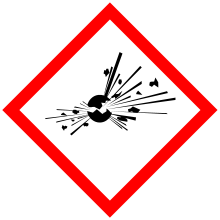Pipe marking
Pipe marking is the usage of labels, typically color coded, to identify the use, contents and flow direction of pipes inside of industrial and commercial buildings. This information assists personnel when carrying out maintenance and emergency personnel when responding to emergencies.
ANSI/ASME Standards
In the United States, Occupational Safety and Health Administration regulations recommend following American Society of Mechanical Engineers Standard A13.1-2015 - Scheme for the Identification of Piping Systems.[1]
The standard states that labels should be placed where easily viewed by a person standing near the pipe at any of the following points:[2]
| Meaning | Background Color | Text Color | Example |
|---|---|---|---|
| Hazardous materials[lower-alpha 1] | Safety Yellow | Black | Acetylene |
| Non-hazardous liquids | Safety Green | White | Stormwater |
| Non-hazardous gases | Safety Blue | White | Nitrogen |
| Firefighting materials | Safety Red | White | Sprinkler Water |
| Meaning | Background Color | Text Color | Example |
|---|---|---|---|
| Flammables[lower-alpha 2] & Oxidizers[lower-alpha 3] | Safety Yellow | Black | Acetylene |
| Combustible Fluids[lower-alpha 4] | Safety Brown | White | Lubricating Oil |
| Toxic and Corrosives | Safety Orange | White | Ammonia |
| Water | Safety Green | White | Stormwater |
| Compressed air/Non-hazardous gases | Safety Blue | White | Compressed Air |
| Firefighting materials | Safety Red | White | Sprinkler Water |
| Custom - Defined by user | Safety Purple | White | Fluid Name |
| Custom - Defined by user | Safety Grey | White | Fluid Name |
| Custom - Defined by user | White | Black | Fluid Name |
| Custom - Defined by user | Black | White | Fluid Name |
2015 revisions
_(R).svg.png)
2015 revisions added oxidizing materials to the existing 'Flammables' classification. The other major change allowed and encouraged labels to incorporate the GHS signal word, hazard pictograms, and hazard statements. This addition helped identify additional dangers when dealing with materials that fit into multiple categories, like Hydrogen sulfide, which is both flammable and toxic.[2]
IIAR BULLETIN #114
In 2014, the International Institute of Ammonia Refrigeration introduced a specialized label design for use when marking pipes associated with refrigeration systems using ammonia, including information such as the physical state, pressure and purpose in the system.[4]
NFPA 99C 2002
The National Fire Protection Association have a special labeling system in the standard for Health Care Facilities, such as hospitals and dentistry offices. This standard puts more emphasis on gases found in Medical gas supply systems, which consist of both oxidizing gases and gases that displace oxygen.[5]
| Gas | Background Color | Text Color |
|---|---|---|
| Carbon Dioxide | Gray | Black or White |
| Helium | Brown | White |
| Medical Air | Yellow | Black |
| Oxygen | Green | White[lower-alpha 5] |
| Oxygen/Carbon Mixtures | Green | White |
| Nitrogen | Black | White |
| Nitrous Oxide | Blue | White |
| Waste Anesthetic Gas Disposal | Purple | White |
| Medical Surgical Vacuum | White | Black |
| Non-Medical Air | Yellow/White Diagonal Striped | Black |
| Non-medical and Level 3 Vacuum | Black/White Diagonal Striped | Black (In box) |
| Laboratory Air | Yellow/White Checkerboard | Black |
| Laboratory Vacuum | Black/White Checkerboard | Black (In box) |
| Instrument Air | Red | White |
See also
- Piping
- American National Standards Institute
- American Society of Mechanical Engineers
Notes
- Explosives, flammables, corrosives, toxic, radioactive, extreme pressures/temperatures.
- Flash point below 100 °F (38 °C; 311 K).[3]
- Oxidizers were added in 2015 update.[3]
- Fluids that can burn, but are not considered 'flammable', flash point at or above 100 °F (38 °C; 311 K).[3]
- Background & Text color can be reversed.
References
- Occupational Safety & Health Administration (November 2016). "1910.261 - Pulp, paper, and paperboard mills". osha.gov. Retrieved 21 March 2019.
1910.261(a)(3)(ii) Scheme for the Identification of Piping Systems, A13.1—1956.
- Brimar Industries. "ANSI/ASME A13.1 2015" (PDF). Pipemarker.com. Archived from the original (PDF) on 21 March 2019. Retrieved 21 March 2019.
- NASA (17 November 2017). "GSFC-STD-8006 - Safety Standard for Ground piping Systems Color Coding and Identification". standards.nasa.gov/. Retrieved 21 March 2019.
- International Institute of Ammonia Refrigeration. "Guidelines for: Identification of Ammonia Refrigeration Piping and System Components" (PDF). Archived from the original (PDF) on 21 March 2019. Retrieved 21 March 2019.
- Craftmark Pipe Markers. "NFPA 99C 2002" (PDF). craftmarkid.com. Archived from the original (PDF) on 21 March 2019. Retrieved 21 March 2019.
.svg.png)
.svg.png)



